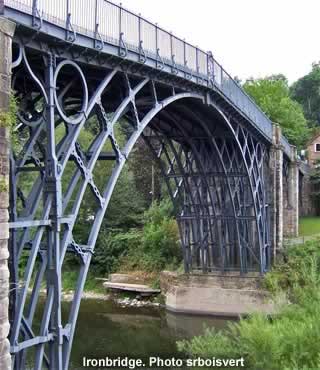Ironbridge |
|
 |
|||
Britain > West Midlands > Ironbridge |
||
A Shropshire Gorge that ended up starting the Industrial Revolution |
||
During the last Ice Age, the River Severn carved out a deep gorge in a part of Shropshire. Many years later, this green, wooded valley was transformed into something unrecognisable. Dozens of factories were built among the trees, manufacturing tiles, porcelain and iron. |
||
You might not expect this quiet corner of the West Midlands to be the birthplace of the Industrial Revolution, but that's exactly what it became. Actually, the gorge proved to be ideal. The exposed rock revealed a huge amount of useful raw materials, like coal, iron ore and limestone. The River Severn provided a perfect method of transport in and out of the area. Thanks to these factors, the valley became a bustling hive of activity. |
||
One key event in the area's history involved a man called Abraham Darby. In the 18th century he built a blast furnace in the nearby town of Coalbrookdale. It was the first in the world to use coke as a fuel, instead of charcoal. Using this revolutionary method, Darby was able smelt iron in larger quantities, at a cheaper price. Following this success, more furnaces and forges were built around Coalbrookdale. Before too long, the gorge was filled with grey smoke and dirty smog. The sound of crashing hammers and groaning machinery echoed around the hills. |
||
In the 1770s, Abraham Darby's grandson made a similarly huge achievement. Using the metal produced at the Coalbrookdale furnaces, he built the world's first cast-iron bridge. The project was vastly over budget, but it was a roaring success, and people came from miles around to see it. Soon, several houses, shops and other buildings began to spring up here. Back then, the bridge was deemed to be so important that it lent this new settlement its name, and the town became known as Ironbridge. In fact, the entire valley is now called Ironbridge Gorge. |
||
Today, the area is recognised for its contribution to British history. In 1986, it became one of the first places in the UK to achieve World Heritage status. This ensures its preservation for the future, so people can't forget the pioneering achievements that were made here. |
||
To learn more, you can visit the Ironbridge Gorge Museums. These are ten separate buildings, which each examine a different aspect of the valley's industrial past. In one, you'll be looking at the gorge, and in another, you'll be looking at the Iron Bridge. Elsewhere, you can design your own tiles, or explore an old tar tunnel. |
||
One of the most popular museums is called Enginuity. It celebrates those little scientific ideas that lead to huge achievements, just like Abraham Darby's blast furnace. There are dozens of hands-on exhibits, where you can build an earthquake-proof tower, or play with an X-Ray machine. |
||
All ten museums are fascinating places, but Ironbridge Gorge itself is also a pleasure to explore. In the 18th century, countless chimneys vomited out vile black smoke, and Coalbrookdale was a maze of grimy back streets. Here in the 21st century, everything has changed. Most of the forges and furnaces now lie ruined or abandoned. The forces of nature have once again exerted their claim on the place, covering the valley with trees and the sound of birdsong. |
||
|
||
Ironbridge Gorge Museums open daily from 10am to 5pm (vary according to museum). Entry to the Museum of the Gorge costs around £4 for adults, £2.50 for children. Entry to all sites costs around £22 for adults, £14.50 for children. Coalbrookdale, Telford, TF8 7DQ. Tel: 01952 433 424 |
||
|
Pocket Britain is optimised for use on a smartphone or tablet with internet access. All content is subject to copyright. All reasonable methods have been used to ensure information supplied is accurate at the time of publication. However, it is advisable to check information before relying on it. Privacy Policy |